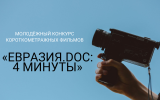In just over a year of its existence, the YouTube channel of the project “Belarus. History” collected almost 2 million views. What is the reason for this success? How and why did the project come about? We asked these and other questions to the people thanks to whom we were able to see him.

Valery Shekhovtsov is the president of the production center “Studio Third Rome”, program director of the Documentary Film Festival “Eurasia.DOC”, head of the project “Belarus. Story”.
— Why exactly the history of Belarus?
— We are implementing a number of projects in the Republic of Belarus. The key one is, of course, the documentary film festival “Eurasia.DOC”, which we will hold for the seventh time in 2022. Some of its main events take place in Minsk. Therefore, everything connected with Belarus is very important and significant for us.
We have also developed not just business, but also friendly relations at the level of interaction between the Belarusian Union of Journalists (BUJ) and the Union of Journalists of Russia (SJR), which I represent in Belarus on a number of issues.
— How did the idea for the project come about?
— At some point, there was a feeling that some representatives of the media and the journalistic community began to overly actively rewrite the history of Belarus with the help of Western NGOs. That is, very important, significant historical events were interpreted in a false light and presented in a completely distorted form.
They tried to impose an alternative history on Belarusians, especially young people, changing black to white, shielding collaborators and criminals, calling into question our achievements and joint victories.
An idea arose – to create a project that, very briefly and in an intelligible form, primarily for young people, would tell about the most significant, key moments of Belarusian history and its true heroes.
We considered the most appropriate format for this to be short videos, no more than 1.5 minutes long, made in the genre of computer animation. Each contains one historical plot. As practice has shown, not only young people, but also people of the older generation watch these videos with pleasure and respond very positively to our project.
— What period of history does the project cover?
— The videos represent all periods of Belarusian history: from the Principality of Polotsk of Ancient Rus’ to the construction of the modern statehood of Belarus.
We pay great attention to the history of our common victories won in the union of the Polotsk and Novgorod principalities in their fight against the crusaders; in confrontation with Sweden; in the War of 1812; during the period of Polish occupation and the fight against it in the 20-30s of the last century; of course, in the Great Patriotic War.
The post-war period is covered quite widely – this is the rise of Soviet Belarus and its flourishing within the Soviet Union.
Some of the videos are dedicated to the history of Belarusians as part of the Grand Duchy of Lithuania and the Polish-Lithuanian Commonwealth. In them we talk about the struggle for the preservation of Orthodoxy on the Belarusian land, as the basis of people’s self-identification in this difficult time.
Orthodoxy, great Belarusian saints, events related to opposition to attempts at Catholicization, in the project “Belarus. History” is given special attention. It’s nice that the Patriarchal Exarch of Belarus, Metropolitan Veniamin, noticed this. At a recent meeting that we were privileged to have, the Head of the Belarusian Orthodox Church spoke in favor of cooperation within the framework of the project, which will be implemented in our new videos.
— During the year of its existence, the YouTube channel “Belarus. History” became a millionaire. Did you predict this number of views or did it come as a surprise to you?
— Of course, we tried to calculate the audience, but first of all we invested in creativity. “We” is a Russian-Belarusian team of historians-consultants, screenwriters, directors, and designers. The apparent “ease of the genre” was achieved through painstaking work.
As a project manager, I am very glad that our team, established in working cooperation, is able to implement large volumes of production in a short time and do it with very high quality. Currently, 45 videos have been produced. We intend to continue this work.
It was very nice that the audience accepted us. We are pleased with the positive responses after watching the videos, and even attempts to oppose us by adherents of that same “alternative” history. Often, although they may not agree with us in essence, they still admit that the quality of our content is very high.
And yet, most of the comments are positive, with gratitude and support for the project and its creators.

— How are you promoting the project?
– “We have been looking for the possibility of its implementation for a very long time. Eventually she showed up. The Belarusian Union of Journalists became a promotion partner in Belarus. We are very grateful to its director Andrey Krivosheev for his comprehensive support not only of this, but also of other projects of our studio.
We couldn’t even imagine that the videos “Belarus. History” will be shown in the Minsk metro, public transport, schools and enterprises. This indicates the high recognition and demand for the project.

Andrey Krivosheev is the Chairman of the Board of the Belarusian Union of Journalists, Executive Director of the Eurasia.DOC festival.
— What interested you in the project? Why did you decide to participate in its promotion on the territory of Belarus?
— Because this project uses new forms and methods of work to convey objective historical knowledge. We often complain that we do not have projects that would convey the real events of Russian history using simple, but at the same time honest, sincere, without fakes, concepts and categories.
On the other hand, young people have a huge demand for such honest, objective, reliable information, presented from the perspective of Belarusian historical memory, our mentality and ethics.
Everything came together here – a short genre, easily digestible animated content and serious content. The videos are made in the format of animated comics, but not vulgar ones that distort reality, but as the beginning of serious, complex analytical information.
— What forms of promotion have already been tried?
— The decision of the Belarusian Union of Journalists to participate in promoting the project was supported by city authorities. Together we launched the videos “Belarus. History” in public transport, in the Minsk metro, and this is a daily reach of more than a million audience. Very quickly we received a flurry of positive feedback from the townspeople.
This form of presentation fits well with the short periods of time that Minsk residents and citizens of Belarus spend on the road. At the same time, they will learn something new, specific from the events of Belarusian history. The project’s videos are also broadcast in other cities.
— In general, what is more – approval or criticism?
— In general, the attitude towards the project is very good. You can see this for yourself by looking at the comments to the videos on the YouTube channel “Belarus. Story” . Even critical reviews, paradoxically, only strengthen his positive perception.

The criticism comes from that small part of Belarusian society that has become a victim of propaganda and false history invented by Polish chauvinists and Ukrainian neo-Nazis with the support of the Soros Foundation and others like it. Any deviation from their historical myth, any attempt to present real facts, they meet with desperate resistance.
But there are videos that evoke the reconciliation of different historical concepts. These are, for example, stories about the early, middle centuries – the times of the formation of the first Slavic principalities on the territory of modern Belarus or the history of the Grand Duchy of Lithuania, Russia and Zhemoit. They reconcile people through that real pantheon of heroes that Belarusians have long developed – these are Francis Skaryna and Kirill of Turov, Simeon of Polotsk and Saint Euphrosyne of Polotsk, who is equally revered by all Christian denominations in Belarus, even the Uniates, who most fiercely defend their view of history.
Although discussions and debates are not bad if they encourage people to seriously study important historical events indicated in the project with an animated touch.
— What, in your opinion, are the prospects for the project?
— The prospects are good. In the history of Belarus and more broadly – Belarusian-Russian, Slavic, there are a huge number of blank spots that, like a vacuum, absorb fakes, lies and provocations. Therefore, the more historical events this multimedia project can cover, the less empty space in our history will be left for falsifiers and provocateurs.
Young people and future generations need to instill a reverent attitude towards their history and protect it. It seems to me that the project “Belarus. History” is a very good tool for achieving this goal.



















